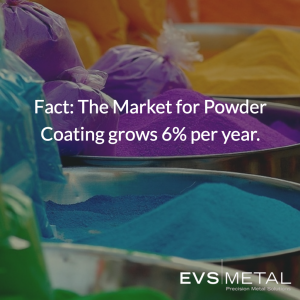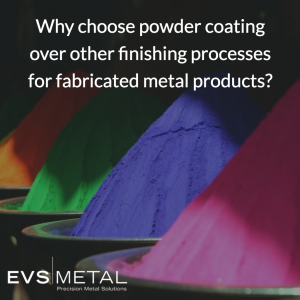 EVS Metal is known for precision metal fabrication, and it’s a point of pride that we are one of the most trusted manufacturers in the industry. However, fabrication of aluminum and steel is only part of what our highly-trained staff does on a given day. While laser cutting systems and press brakes make up a large part of our projects, finishing processes are also incredibly important to what we do, especially for items that aren’t simply pieces of a larger product. When we fabricate an end product, whether for an industrial/commercial setting or for use by consumers, it must look truly finished in order for it to ship. One of the ways in which we ensure this is via powder coating.
EVS Metal is known for precision metal fabrication, and it’s a point of pride that we are one of the most trusted manufacturers in the industry. However, fabrication of aluminum and steel is only part of what our highly-trained staff does on a given day. While laser cutting systems and press brakes make up a large part of our projects, finishing processes are also incredibly important to what we do, especially for items that aren’t simply pieces of a larger product. When we fabricate an end product, whether for an industrial/commercial setting or for use by consumers, it must look truly finished in order for it to ship. One of the ways in which we ensure this is via powder coating.
How Does Powder Coating Work?
Powder coating was first introduced to North America in the 1960s and it completely changed the way products are finished in a revolutionary way; in fact, when you break it down, it’s truly a scientific marvel. Gone were the days of spray painting (and re-painting and re-painting again) metal products. It works via a process called electrostatic spray deposition (ESD), which allows colored coatings (usually a combination of powdered polymer resins, pigments, curatives and leveling agents) to be applied via a spray gun. Essentially, an electrostatic charge is supplied by the gun which is then applied to the colored powder which allows it to bond to the grounded metal item being coated. The item is then transferred to a curing oven, which uses very high heat to harden the powder into a molecularly-dense protective top layer. While there are other types of powder coating, such as fluidized bed application, ESD is still by far the most common process.
How is Powder Coating Used?
Powder coating is used in two ways — decoratively and protectively. Because the molecular structure produced from powder coating is so strong and durable, it’s not uncommon to see products that may never see the light of day powder coated for protection, whether from the elements, like rain, extreme heat, friction or other forms of wear and tear resulting from use. But it’s also incredibly popular for decorative use, too. Products such as bicycle frames, self-service kiosks, snowmobiles, fire extinguishers and vending machines are all powder coated to enhance both the look and the durability of the items. But it’s not just large items that are powder coated. Very small items like thumbtacks and mechanical pencils are also powder coated because it just makes financial sense. Powder coating is generally an economical process when done on a large scale, while hand-painting is not. That makes small products that are mass-produced prime candidates.
Regardless of the type of item being finished and why a manufacturer chooses to use powder coating over other available options, what’s universal is that the process is a relatively uncomplicated, unbelievably durable, extremely cost-effective choice that lacks many of the environmental concerns that other finishing processes hold.
What are the Two Main Types of Powder Coating?
There are two primary powder coating categories: thermoplastics, which can be remelted into a liquid state; and thermosets that never leave their solid form. Both use a range of polymers, including fusion-bonded epoxy, polyurethane and polyester, just to name a few. As might be expected, thermosets are the best choice when a product will be subject to high levels of heat, as they are unlikely to melt once cured into their final shape or form. Thermoplastics, on the other hand, are best for applications where cosmetic finishes are desired but durability isn’t quite as much of an issue. In the end, neither is better and both are needed and respected in the powder coating world.
Why Choose Powder Coating Over Other Metal Finishing Processes?
 Besides the lower levels of VOCs emitted — especially in comparison to paint — powder coating has other advantages too. It can produce much thicker coatings than liquid paints, and those coatings are also more evenly spread, especially in terms of horizontally- vs. vertically-coated surfaces, which means creating a smooth surface is fairly simple to do, without bubbles or visible paint lines. Powder coating allows color blending to be done right on the item itself.
Besides the lower levels of VOCs emitted — especially in comparison to paint — powder coating has other advantages too. It can produce much thicker coatings than liquid paints, and those coatings are also more evenly spread, especially in terms of horizontally- vs. vertically-coated surfaces, which means creating a smooth surface is fairly simple to do, without bubbles or visible paint lines. Powder coating allows color blending to be done right on the item itself.
However, regardless of the type of item being finished and why a manufacturer chooses to use powder coating over other available options, what’s universal is that the powder coating process is a relatively uncomplicated, unbelievably durable, extremely cost-effective choice that lacks many of the environmental concerns that other finishing processes hold.
Because of the flexibility and durability of powder coating as a finishing process, there is near-constant growth in the category. Global demand was about $5.8 billion in 2010, is expected to top $17B by 2025. As a leader in contract manufacturing, EVS Metal will continue to invest in the skilled operators and equipment required to meet the needs of our customers across North America whose projects are best completed with the latest advances in powder coating techniques, materials and machines.
EVS Metal provides a range of precision fabrication, CNC machining and metal finishing services to a diverse customer base, from quick-turn prototypes to high-volume production runs. Discover how our top-of-the-line, in-house powder coating lines in New Jersey, Pennsylvania, Texas and New Hampshire can add value to your manufacturing supply chain today; simply request a quote online, or give us a call at (973) 839-4432.





